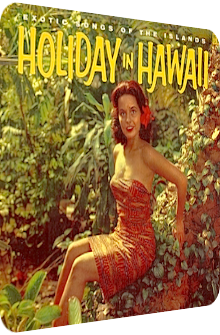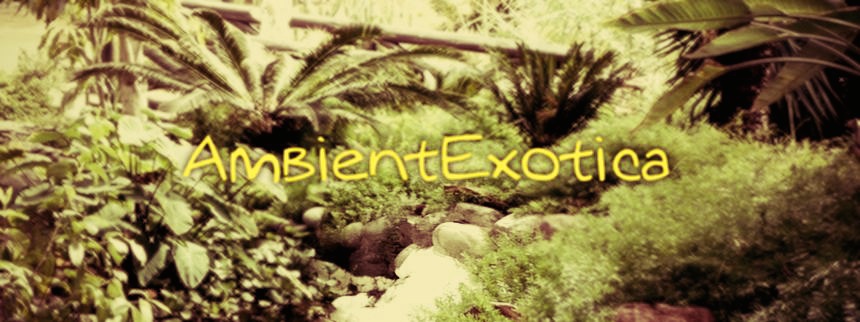
Makamia & His Moana Islanders
Holiday In Hawaii
1957
If there is one cliché about Hawaiian music that has been beaten to death, mentioned in millions of cartoon series and prominently placed in advertisements, sitcoms and any other form of sound-underlined medium, it has to be the enormous dreaminess of a gently played steel guitar, backed by the drier, even more sunlit plucking on a ukulele. Such music is called Hapa Haole. Traditional Hapa Haole albums are artifacts that have outlived Exotica by decades and even continued to gain traction when that beloved genre was on a decline in the middle of the 60’s. Okay, so Hapa Haole outlived Exotica; but did it also outlove Exotica, if that makes any sense?
Considering the LP and once-in-a-lifetime gathering of Makamia And His Moana Islanders, chances are that the beaten paths of Hawaiian music encounter a little refreshment. Released in 1957 on the Remington label and subsequently cross-licensed, the ten classical and not so well-known songs offer a few delightful alterations that let the album tower above the bog-standard competition, albeit not overly much. Exotica fans should not hold their breath, as transitions amid the Hapa Haole genre are much smaller than the flamboyancy of an orchestra leader’s possibilities suggests. Be that as it may, Makamia’s trio (or quartet, I’m not sure) not only delivers material that fans of Alfred Apaka can sing along to, they also add adjuvants that are not necessarily found in the genre: vibraphones, hi-hats and – gasp! – even bongos make it to one song or another.
In addition, there are four vocal tracks gathered on side B for those listeners who might enjoy an oily, suave performance. Even if this is not the case, Hapa Haole albums are usually of interest to the Exotica fan for one particular reason: the colorful translucency of the steel guitar. And rest assured that steel guitarist Makamia knows how to treat this signature instrument in order to let it spawn multitudes of vivacity and colors. This is indeed the high point of Holiday in Hawaii, with its other boons and setbacks mentioned below.
Talking about the cliché mentioned above, it is terrifically brought to life in the very first moment of the traditional classic Waipio. Thanks to its appearance on Martin Denny’s benchmark Exotica (1957) and Arthur Lyman's dreamland Hawaiian Sunset (1959), it has gained a cult following among fans who prefer a more languorous take and less cinematic haste. Makamia And His Moana Islanders do the pipe dream scenery justice by unleashing superfluids of soaked steel guitars. The warped elasticity, the rising otherworldly afterglow, the interstitial slackery, it is all in these chords. But wait, there’s more! No, not the ukulele, for it is a mandatory ingredient; it is the well-hidden vibraphone that cautiously illumines the reverie from behind. The main melody might be the true achievement and instantly recognizable by genre aficionados, but the flittering haze of the vibraphone’s sustain adds a pinch of Lymanism to the shore. Harry Hougassian’s and Princess Likelike’s
Ainahau is next, elbowing away the dreaminess in favor of a mildly hillbilly-esque capsule of Hawaiiana with saltatory dialogs between the steel guitar and the ukulele – including some surprisingly scourging licks – and the inclusion of a mellowly played classic drum kit whose hi-hats are more of a breeze than an eruptive force. Johnny Lum Ho’s Makalapua meanwhile returns to hammock-friendly climes and finds its many afternoon chords encapsulated in helicoidal vibraphone goodness, whereas the plain English stopover One, Two, Three, Four carves out the lilac-colored vibes even more in adjacency to the simmering melting pot of the steel guitar and the ukulele, with the last song of side A, Johnny Noble’s transcription of Ta Hu Wa Hu Wa Hi aka Hawaiian War Chant, brings in high-plasticity bongos to the album’s endemics. Hawaiian War Chant, if played correctly, always showcases the importance and vividness of the drums, and Makamia takes a bow before this concept and interweaves the bongos in coruscating steel guitars and blazing ukulele strums.
Side B could be called the vocal side; its material definitely derives from the same session and is delivered by the same band, but widens the intrinsic formula quite a bit. It launches with Halona by Clyde Halema’uma’u Sproat, and in the context of Hapa Haole, the listener is advised to listen closely for a long period of time, as this song almost crosses the four-minute mark. This is by no means the only surprise: Makamia And His Moana Islanders sing along to the moony reticulation. It is here where a certain chintziness cannot be denied anymore, so the Exotica fan might shy away from the antediluvian but truthful vocal component. In short: Halona features a barber shop quartet… in Hawaiian style. Ua Like No Ia Like is one of Makamia’s own visions, yet again fond of a vocal performance, but presented here in true bandleader fashion, mostly comprising of Makamia’s solo vocals, with the band joining in the last third only. Fans of Alfred Apaka will have a field day with this unique piece. A curious but successful formula is delivered by its trisection: first an instrumental part, then Makamia’s solo, finally the whole crew altogether.
While William Pitt Leleiohoku II’s Aloha No Au I Ko Maka carves out the importance of the ukulele as a rhythm device whose attendance is held together by the plinking aureoles of the steel guitar and only features one little vocal-based intermission at its apex, the traditional Waialae takes the cake length-wise with a runtime of a whopping five minutes, allowing almost progressive turns of events. The song remains stable though, with a solemn concoction of steel guitars and pirate-like shanties thrown in for good measure. The endpoint is – you’ve guessed it – a rendition of Queen Lydia Lili’uokalani’s Aloha Oe. If you are still able to absorb the ubiquity of the gazillions of interpretations, Makamia’s take is not the worst one to digest, as he and his band return to the successful tradition of a steel guitar, ukulele and vibraphone. Especially the glinting aura of the latter adds much luminosity to this string-focused endeavor.
Holiday In Hawaii is a strikingly multifaceted work, and no, my face doesn’t turn red, I’m not exaggerating if the rules and traditions of Hapa Haole are applied. Sure, Exotica followers might laugh the flimsy changes away: a classic drum kit on one song, the scents of vibraphones on many others, with the appearance of bongos on another shanty, big deal! And yes, it is true that Makamia And His Moana Islanders do not view the Hawaiian style from a new, let alone twisted angle in the veins of, say, the Belgian combo The Waikikis on their album Hawaii Tattoo (1962), but all these things and thoughts aside, Holiday In Hawaii offers plenty of surprises housed in a smaller frame. Side A is exclusively based on instrumentals and is therefore the side which lives up best to the demands of the Exotica crowd. No matter how small the battery of bongos or commonplace the appearance of the vibes are, these devices are still most welcome in this genre. It is nice to see little changes to the adamant formula of one or two steel guitars and an additional ukulele.
Side B harbors four vocal tracks, and these are probably the Achilles Heel on the album, depending on the listener and his or her familiarity with the material in particular and vocal-based tropical music in general. The performances are quite a bit schmaltzy when analyzed today, but then again, they probably offer the greatest amount of escapism in the end. Holiday In Hawaii succeeds with enormously scintillating influxes of steel guitar sustain and ukulele droplets, and to round things off, it also adds a mallet instrument to most arrangements. It is therefore one of the more valuable LP’s to own. Unfortunately, a digital reissue has never seen the light of day, but the vinyl turns up on eBay, GEMM and other collector’s places time and again and has therefore gained a small cult following. Fans of Harry Kaapuni’s Aloha Hawaii and Blue Hawaiian Waters (both 1960) or Johnny Pineapple’s similarly titled Hawaiian Holiday (1965) should give it a go.
Exotica Review 343: Makamia & His Moana Islanders – Holiday In Hawaii (1957). Originally published on May 24, 2014 at AmbientExotica.com.
